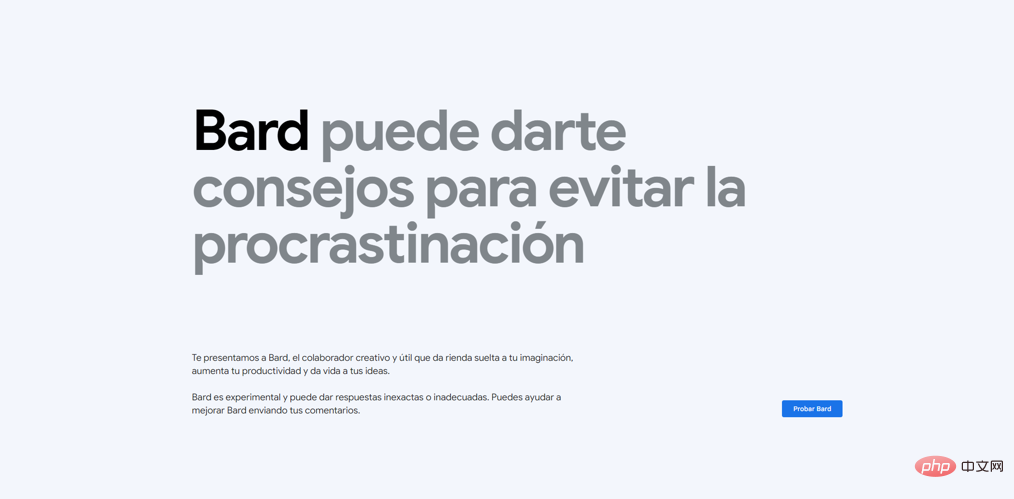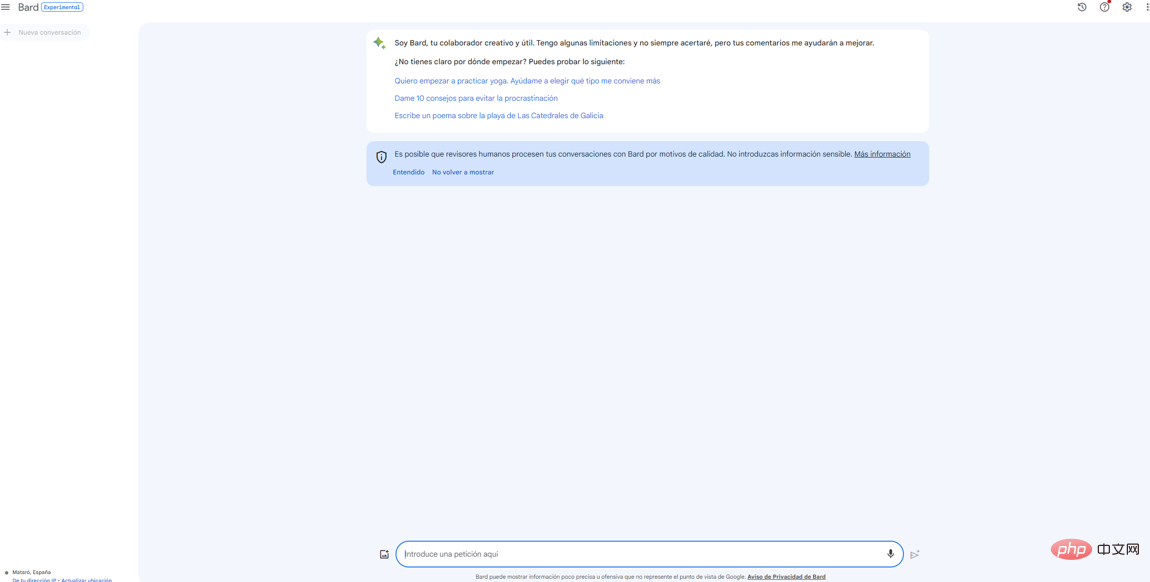Bard: A new competitor to ChatGPT
In the continuous pursuit of optimizing the artificial intelligence user experience, Google has launched the latest and most advanced conversation system Bard.
This innovative tool not only differentiates itself from other systems like ChatGPT by being able to stay up-to-date via a permanent connection to the internet, but it also aims to revolutionize the way we interact with technology. From its ability to interpret and describe images to its excellent integration with other leading services like Gmail, Docs, and Google Lens, Bard is becoming the central link in Google's ecosystem of services. Additionally, its partnership with Adobe Firefly promises unprecedented levels of visual content generation and understanding. Although still in the experimental stage, Bard promises to redefine the boundaries of what we can expect from artificial intelligence systems.
In this article, we’ll take an in-depth look at Bard’s features, capabilities, and transformative potential in computing and communications.
What is Bard?
Google has developed an advanced artificial intelligence system called Bard. The system allows interaction with users via traditional text messages. Individuals can ask questions or request specific action and Bard will respond appropriately.
This innovative artificial intelligence system from a well-known technology company is based on LaMDA, a complex language model designed for conversational applications. For some time, LaMDA has been in a restricted evaluation phase, accessible only to a select group of people.
Interestingly, Google has considered LaMDA as a potential competitor to ChatGPT since its inception. However, given that it's not yet completely perfected, the company has chosen to keep it in an experimental stage so as not to damage its reputation.
The name LaMDA comes from the abbreviation of "Language Model for Conversational Applications". Nonetheless, when it was officially released, Google decided to rename it "Bard." During its development, LaMDA has had a few anecdotes, such as the case of an engineer who was fired after suggesting the system had a "conscience."
At the European level, particularly in the EU, the initial deployment of Bard has been delayed. The fundamental reason is that Google needs to make its system compliant with the Data Protection Regulation (GDPR) and other relevant regulations. However, as of July 13, 2023, Bard has finally entered the Spanish market.
In terms of functionality, Google clarified that Bard has the ability to collect information from the web to provide "accurate and up-to-date answers." Its main purpose is to provide users with comprehensive and clear answers on any topic, thereby enhancing web searches through the use of natural language.
Differences between Bard and ChatGPT
One of the distinguishing features of Bard is its constant connection to the internet. This functionality is crucial, especially compared to systems like ChatGPT that do not maintain such connections. Therefore, while ChatGPT may provide outdated information, Bard is positioned as a newer tool.
One of the most novel aspects of Bard is its ability to interpret images. The system currently allows the inclusion of image links, and it is expected that in the near future it will be possible to attach images directly from personal devices. This feature allows Bard to provide detailed descriptions of related images. However, it is worth mentioning that, as with ChatGPT and other text generation systems, accuracy is not always guaranteed. While it may provide a general idea of the content, it is the user's responsibility to verify the accuracy of the information provided.
Another difference between Bard and systems like ChatGPT is the ability to provide voice responses. This feature is particularly useful when users cannot read lengthy responses. Additionally, it is an important tool for people with visual impairments, allowing them to access AI-generated information.
For users accustomed to using Google apps, Bard promises to be a tool that optimizes their daily experience. It is expected to integrate with Gmail and Docs, facilitating AI-generated responses interacting with these services. Additionally, Google Lens will be embedded into its interface, enabling image-rich queries for more accurate results. Google's fundamental goal is to enable efficient interconnection of its services through Bard.
Along the same lines of expansion, Google announced a partnership with Adobe Firefly. In addition to image interpretation, this collaboration is expected to bring image generation capabilities to Bard, further enriching the system’s visual capabilities.
How to Test Bard
For anyone who wants to try this new artificial intelligence, all we have to do is visit the link below and sign up for our Google account .

Now you will see a button with the option "Test Bard". Click on it and accept the platform's terms and conditions.
Finally Google will warn us that Bard is in experimental status, and once we close this dialog box, we can start using Bard for free.

As we explained in our article about ChatGPT, Bard works exactly the same way. You have to ask it some questions in the text box and the AI will try its best to give you the answers you expect.
Conclusion
In the current field of artificial intelligence, the emergence of Bard signals Google’s commitment to revolutionizing user interaction with technology.
Unlike other systems, its constant connection to the network makes it an always up-to-date source of information, while its ability to interpret images and provide voice responses broadens its scope of utility. Planned integrations with Google’s flagship services and partnership with Adobe herald a future in which Bard will become the backbone of an integrated and visually rich digital ecosystem.
Although Bard is still in the experimental stage, its prospects are encouraging. As with any emerging technology, it is critical that users and developers gain insight into its capabilities and limitations. However, one thing is for sure: with Bard, Google is taking a bold step into the future of communication and information search through artificial intelligence.
The above is the detailed content of Bard: A new competitor to ChatGPT. For more information, please follow other related articles on the PHP Chinese website!

Hot AI Tools

Undresser.AI Undress
AI-powered app for creating realistic nude photos

AI Clothes Remover
Online AI tool for removing clothes from photos.

Undress AI Tool
Undress images for free

Clothoff.io
AI clothes remover

AI Hentai Generator
Generate AI Hentai for free.

Hot Article

Hot Tools

Notepad++7.3.1
Easy-to-use and free code editor

SublimeText3 Chinese version
Chinese version, very easy to use

Zend Studio 13.0.1
Powerful PHP integrated development environment

Dreamweaver CS6
Visual web development tools

SublimeText3 Mac version
God-level code editing software (SublimeText3)

Hot Topics
 1376
1376
 52
52
 ChatGPT now allows free users to generate images by using DALL-E 3 with a daily limit
Aug 09, 2024 pm 09:37 PM
ChatGPT now allows free users to generate images by using DALL-E 3 with a daily limit
Aug 09, 2024 pm 09:37 PM
DALL-E 3 was officially introduced in September of 2023 as a vastly improved model than its predecessor. It is considered one of the best AI image generators to date, capable of creating images with intricate detail. However, at launch, it was exclus
 The perfect combination of ChatGPT and Python: creating an intelligent customer service chatbot
Oct 27, 2023 pm 06:00 PM
The perfect combination of ChatGPT and Python: creating an intelligent customer service chatbot
Oct 27, 2023 pm 06:00 PM
The perfect combination of ChatGPT and Python: Creating an Intelligent Customer Service Chatbot Introduction: In today’s information age, intelligent customer service systems have become an important communication tool between enterprises and customers. In order to provide a better customer service experience, many companies have begun to turn to chatbots to complete tasks such as customer consultation and question answering. In this article, we will introduce how to use OpenAI’s powerful model ChatGPT and Python language to create an intelligent customer service chatbot to improve
 How to install chatgpt on mobile phone
Mar 05, 2024 pm 02:31 PM
How to install chatgpt on mobile phone
Mar 05, 2024 pm 02:31 PM
Installation steps: 1. Download the ChatGTP software from the ChatGTP official website or mobile store; 2. After opening it, in the settings interface, select the language as Chinese; 3. In the game interface, select human-machine game and set the Chinese spectrum; 4 . After starting, enter commands in the chat window to interact with the software.
 How to develop an intelligent chatbot using ChatGPT and Java
Oct 28, 2023 am 08:54 AM
How to develop an intelligent chatbot using ChatGPT and Java
Oct 28, 2023 am 08:54 AM
In this article, we will introduce how to develop intelligent chatbots using ChatGPT and Java, and provide some specific code examples. ChatGPT is the latest version of the Generative Pre-training Transformer developed by OpenAI, a neural network-based artificial intelligence technology that can understand natural language and generate human-like text. Using ChatGPT we can easily create adaptive chats
 Can chatgpt be used in China?
Mar 05, 2024 pm 03:05 PM
Can chatgpt be used in China?
Mar 05, 2024 pm 03:05 PM
chatgpt can be used in China, but cannot be registered, nor in Hong Kong and Macao. If users want to register, they can use a foreign mobile phone number to register. Note that during the registration process, the network environment must be switched to a foreign IP.
 How to use ChatGPT and Python to implement user intent recognition function
Oct 27, 2023 am 09:04 AM
How to use ChatGPT and Python to implement user intent recognition function
Oct 27, 2023 am 09:04 AM
How to use ChatGPT and Python to implement user intent recognition function Introduction: In today's digital era, artificial intelligence technology has gradually become an indispensable part in various fields. Among them, the development of natural language processing (Natural Language Processing, NLP) technology enables machines to understand and process human language. ChatGPT (Chat-GeneratingPretrainedTransformer) is a kind of
 How to build an intelligent customer service robot using ChatGPT PHP
Oct 28, 2023 am 09:34 AM
How to build an intelligent customer service robot using ChatGPT PHP
Oct 28, 2023 am 09:34 AM
How to use ChatGPTPHP to build an intelligent customer service robot Introduction: With the development of artificial intelligence technology, robots are increasingly used in the field of customer service. Using ChatGPTPHP to build an intelligent customer service robot can help companies provide more efficient and personalized customer services. This article will introduce how to use ChatGPTPHP to build an intelligent customer service robot and provide specific code examples. 1. Install ChatGPTPHP and use ChatGPTPHP to build an intelligent customer service robot.
 GPT-4 was exposed as cheating! LeCun calls for caution when testing on training set, chihuahua or muffin order confusion leads to errors
Nov 13, 2023 pm 08:17 PM
GPT-4 was exposed as cheating! LeCun calls for caution when testing on training set, chihuahua or muffin order confusion leads to errors
Nov 13, 2023 pm 08:17 PM
GPT-4 solved the famous Internet meme "Chihuahua or blueberry waffle", which once amazed countless people. However, now it is being accused of "cheating"! The pictures are all from the ones that appear in the original title, but the order and arrangement are messed up. The latest version of GPT-4 is famous for its all-in-one feature. However, surprisingly, it made errors in the number of images it recognized, and even the Chihuahua, which was originally correctly recognized, also recognized incorrect images. What is the reason why GPT-4 performs so well on the original image? According to XinEricWang, assistant professor at UCSC, the reason for conducting this test is because the original images on the Internet are too popular. He believes that GPT-4 encountered the original answers many times during training and successfully memorized them Turing




